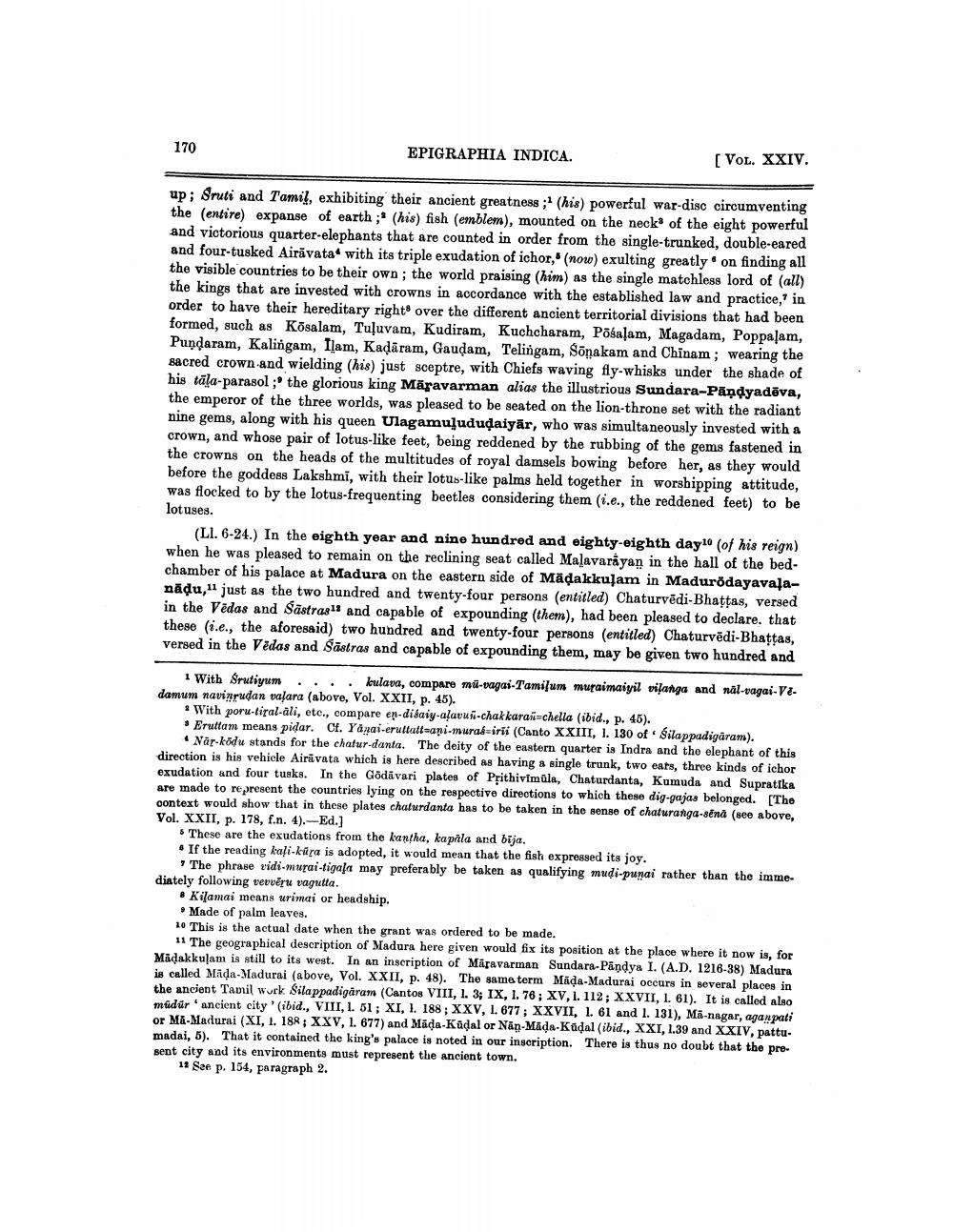________________
170
EPIGRAPHIA INDICA.
(VOL. XXIV.
up; Sruti and Tamil, exhibiting their ancient greatness ;' (his) powerful war-disc circumventing the entire) expanse of earth ;' (his) fish (emblem), mounted on the necks of the eight powerful and victorious quarter-elephants that are counted in order from the single-trunked, double-eared and four-tusked Airāvata with its triple exudation of ichor," (now) exulting greatly on finding all the visible countries to be their own; the world praising (him) as the single matchless lord of (all) the kings that are invested with crowns in accordance with the established law and practice, in order to have their hereditary right over the different ancient territorial divisions that had been formed, such as Kösalam, Tuļuvam, Kudiram, Kuchcharam, Posalam, Magadam, Poppalam, Pundaram, Kalingam, Tlam, Kadāram, Gaudam, Telingam, Sõnakam and Chinam; wearing the sacred crown and wielding (his) just sceptre, with Chiefs waving fly-whisks under the shade of his täla-parasol; the glorious king Māravarman alias the illustrious Sundara-Pāņdyadēva, the emperor of the three worlds, was pleased to be seated on the lion-throne set with the radiant nine gems, along with his queen Ulagamulududaiyār, who was simultaneously invested with a crown, and whose pair of lotus-like feet, being reddened by the rubbing of the gems fastened in the crowns on the heads of the multitudes of royal damsels bowing before her, as they would before the goddess Lakshmi, with their lotus-like palms held together in worshipping attitude, was flocked to by the lotus-frequenting beetles considering them (i.e., the reddened feet) to be lotuses.
(LI. 6-24.) In the eighth year and nine hundred and eighty-eighth day (of his reign) when he was pleased to remain on the reclining seat called Malavarayan in the hall of the bed chamber of his palace at Madura on the eastern side of Māļakkulam in Madurodayavalanādu, just as the two hundred and twenty-four persons (entitled) Chaturvēdi-Bhattas, versed in the Vēdas and Sāstrasls and capable of expounding (them), had been pleased to declare that these (i.e., the aforesaid) two hundred and twenty-four persons (entitled) Chaturvēdi-Bhattas, versed in the Vedas and Sāstras and capable of expounding them, may be given two hundred and
1 With Srutiyum .... kulava, compare mu-vagai-Tamilum muraimaiyil vilanga and nål-vagai-Vedamum navinrudan valara (above, Vol. XXII, p. 45).
# With poru-tiral-ali, etc., compare en-dibaiy-alavu-chakkarai=chella (ibid., p. 45). • Eruttam means pidar. Cf. Yanai-eruttatt-ani-muras=irii (Canto XXIII, 1. 130 of Silappadigaram).
Når-kodu stands for the chatur-danta. The deity of the eastern quarter is Indra and the elephant of this direction is his vehicle Airavata which is here described as having a single trunk, two eats, three kinds of ichor exudation and four tusks. In the Godavari plates of Prithivimüla, Chaturdanta, Kumuda and Supratika are made to represent the countries lying on the respective directions to which these dig-gajas belonged. [The context would show that in these plates chaturdanta has to be taken in the sense of chaturanga-sēna (see above, Vol. XXII, p. 178, f.n. 4).-Ed.]
These are the exudations from the kantha, ka pila and bija. . If the reading kali-kira is adopted, it would mean that the fish expressed its joy.
* The phrase vidi-murai-tigala may preferably be taken as qualifying mudi-punai rather than the immediately following vervēru ragutta.
& Kifamai means urimai or headship. . Made of palm leaves. 10 This is the actual date when the grant was ordered to be made.
11 The geographical description of Madura here given would fix its position at the place where it now is, for Madakkulam is still to its west. In an inscription of Māravarman Sundara-Pandya I. (A.D. 1216-38) Madura is called Mada-Madurai (above, Vol. XXII, p. 48). The same term Māda-Madurai occurs in several places in the ancient Tamil wurk Silappadigaram (Cantos VIII, 1. 3; IX, 1.76; XV, 1.112; XXVII, 1. 61). It is called also mtidur ancient city' (ibid., VIII, 1. 51; XI, 1. 188; XXV, 1. 677; XXVII, 1. 61 and 1. 131), Mā-nagar, ajanpati or Má-Madurai (XI, 1. 188; XXV, 1. 677) and Mada-Kudal or Nān-Māda-Kudal (ibid., XXI, 1.39 and XXIV, pattumadai, 5). That it contained the king's palace is noted in our inscription. There is thus no doubt that the present city and its environments must represent the ancient town.
11 See p. 154, paragraph 2.




